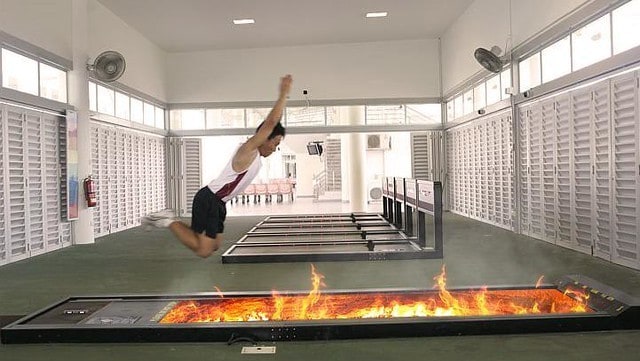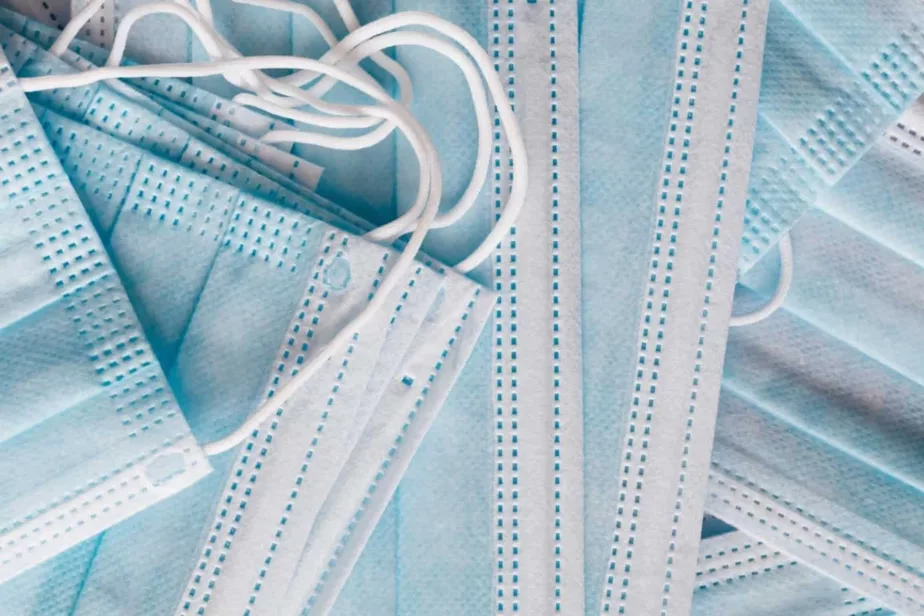Coaching Behind a Mask
COVID-19 implications for the S&C Coach
- Introduction
- Masking the Realities
- Unmasking the Realities
- Summary
- Pro-tips
- About the Author
- References
- Comments

Introduction
The pandemic created some unique challenges for strength and conditioning (S&C) coaches to deliver their usual on-site training sessions. One of the hurdles that immediately stands out is the wearing of a face mask to coach indoors. Though cumbersome for a variety of reasons to be highlighted later in this article, it is highly recommended that all S&C coaches adhere to this health advisory.
The National Health Service (NHS) recommends that people wear face masks in public settings, especially when in close contact with one another [within 2 meters (6 Feet)] (2). Face masks are recommended as a simple barrier to help prevent respiratory droplets from travelling into the air and onto other people as talking, coughing, sneezing and raising your voice can all increase the chances of respiratory droplets from travelling. This simple action may help slow the spread of the Coronavirus Disease 2019 (COVID-19). Athletes who are engaged in high-intensity training (e.g. weightlifting), may be excused from wearing a face mask if it causes difficulty breathing.
The aims of this article were to share lessons learned in cueing, coaching and programming considerations while wearing a face mask.
Masking The Realities
Below are crucial aspects of coaching that can be made challenging while wearing a face mask:
Facial expressions
Face masks don’t just make the transportation of respiratory droplets but also facial expressions for both the coach and athletes. The loss of this element of body language can leave loopholes in communication between coach and athlete. Coaches may not realise that an encouraging smile, disciplining frown or confused thinking face can go unnoticed by athletes during a training session, which would usually compliment a statement made by coaches, leading to misinterpretation or affecting rapport.
Voice projection
The usual loud projection of a coach’s voice is instantly impacted while donning a face mask during coaching. A lot of times, a coach may not realise that their “coaching voice” is now muffled, too soft or simply inaudible to their group of athletes in the weight room. The constant adjustment of the pitch, at the very least, interrupts the flow of the training session, the reception of key coaching cues and verbal encouragement and feedback during sets.
Physically taxing
All the above points create an unrealised physical and/or psychological stress for the coach executing his job. The stress may not induce the same response as the elevation training masks that purportedly simulate altitude training, but it still does make a coach’s bodywork harder to breathe (3) The “restricted-air training” also increases a coach’s need to quench his thirst on a more frequent basis.
Unmasking The Realities
Here are 3 broad hacks to assist coaches to overcome the constraints faced by wearing a face mask for coaching.
1. External cues
Coaching athletes with short sentences through cues may assist the coach to facilitate an S&C session with few, but impactful instructions. The goal of cueing is to narrow the athlete’s attention to focus on the most relevant feature of a movement being learned (e.g. Triple extension in a horizontal broad jump).
External cues (as opposed to internal cues) are often used to encourage the athlete to focus their attention on the movement outcome. Research has shown that an external focus of attention (through the manipulation of distance, direction and description strategies) promotes greater movement velocity, force, endurance, and efficiency (1, 4). In the long run, the athlete will perform better during the context of practice, while encouraging the retention and transfer of the practised motor skill.
To illustrate the application of the external cue strategy, consider a coach asking his athlete to ace the horizontal broad jump.
– Internal cue: “Focus on extending through the hips, knees and ankles”
– External cue: “Explode over a bed of hot coals”
Once the athlete has heard a cue like this once or twice, it can be even further abbreviated to a buzzword such as “COALS!” to trigger an image and action in the athlete’s mind to achieve the outcome intended by the coach.

2. Training aids
This season brings back time-tested training aids that old-school coaches still stick to for their S&C sessions. The earbuds (aka wireless microphone) can be used to aid the projection of a coach’s voice in large group settings. The latest sets have long battery lives and are even water/sweatproof, amplifying a coach’s pitch with a simple Bluetooth connection to the sound system in the training facility. Save your voice by working smarter, not harder.
The tablet (aka whiteboard) with the workout of the day in large fonts helps athletes follow along with the training program. Any visual props do help coaches conserve energy and more importantly, their voices. Furthermore, bringing back the chalkboard makes you a hipster coach.
The gym props (in the absence of tactile cueing or manual adjustment due to current physical distancing measures) can help to reinforce movements, postures and set-ups for athletes. It’s time to bring back the previously utilised sticks, mini-bands and skipping ropes. Just ensure that all the training accessories used are adequately wiped down and sanitised after each use.
Video 1. Single-Leg Romanian Deadlift (SL-RDL): Placing a stick or resistance band along the ipsilateral shoulder and foot helps to provide a tactile cue to maintain a straight posture of the torso with the swing leg.
3. Manipulation of coaching style (aka self-preservation)
Major sports brands have given back by producing quality face masks with the sportsman in mind. These masks are structurally designed to sit up off the face and lips for added comfort and breathability while training. Other features also include water resistance, anti-microbial treatment and UPF 50+ sun protection, making it a great choice for coaches that need to bring coaching outdoors.
The fogging of glasses and the masks getting wet through perspiration are common nauseous while wearing a face mask. If a coach wears glasses, a quick strategy would be to breathe through the mouth with pursed lips. Coaches should also shave the beard, as facial hair traps more moisture and make the face mask ill-fitting. One’s drinking strategy is another consideration while donning a face mask to the coach. A quick solution is to have a straw with your sports bottle to enable a coach to keep hydrated without constantly adjusting the face mask while coaching.
The last consideration is the coaching and program delivery. Many facilities have emplaced strict measures aligned with their countries’ current regulations in tackling the ongoing COVID-19 situation. Considering the operational flows, mapping out the athletes’ training areas, and knowing the training flows and transitions, will allow the forward-thinking coach to be well prepared, which will be a time and energy saver.
Hacking the environment to allow a coach to better position themselves (best possible placement to be seen and heard) and demonstrate exercise techniques (probably more while wearing a face mask), will allow a better overall user experience for sports teams and athletes. Where appropriate and with facility guidelines being followed, consider co-coaching with a second coach to help with the exercise demonstrations, team breakouts and overall facilitation of the S&C session.
Summary
The aims of this article were to share lessons learned in cueing, coaching and programming considerations while wearing a face mask. It is also a great opportunity for coaches to evaluate their current coaching language, and change what may have been previously some suboptimal cues into more effective alternatives. Wearing a face mask is a small price to pay for keeping the athletes around us safe and well. Embrace that face masks are a symbol of the pandemic era.
Pro-tips
- If you have not filmed your coaching session, try it!
- Reviewing it can help highlight what kind of instructions you are providing, which you may not have realised while coaching.
- Stay strong, stay safe!
Filming oneself in coaching mode will help coaches perform a self-analysis of their current program delivery and instructional methods. Having a checklist to discuss with a senior coach will help leapfrog one’s competency in the art of coaching.
- Benz, A., Winkelman, N., Porter, J., & Nimphius, S. (2016). Coaching instructions and cues for enhancing sprint performance. Strength & Conditioning Journal, 38(1), 1-11.
- Considerations for Wearing Masks: Help Slow the Spread of COVID-19. (2020) Retrieved from https://www.nhs.uk/conditions/covid-19/how-to-avoid-catching-and-spreading-covid-19/#:~:text=How%20to%20reduce%20your%20risk,your%20hands%20are%20not%20clean..
- Porcari, J. P., Probst, L., Forrester, K., Doberstein, S., Foster, C., Cress, M. L., & Schmidt, K. (2016). Effect of wearing the elevation training mask on aerobic capacity, lung function, and haematological variables. Journal of sports science & medicine, 15(2), 379.
- Winkelman, N. C. (2018). Attentional focus and cueing for speed development. Strength & Conditioning Journal, 40(1), 13-25.
Benz, A., Winkelman, N., Porter, J., & Nimphius, S. (2016). Coaching instructions and cues for enhancing sprint performance. Strength & Conditioning Journal, 38(1), 1-11.
How to avoid catching and spreading COVID-19 infection. (2020) Retrieved from [Link]
Porcari, J. P., Probst, L., Forrester, K., Doberstein, S., Foster, C., Cress, M. L., & Schmidt, K. (2016). Effect of wearing the elevation training mask on aerobic capacity, lung function, and haematological variables. Journal of sports science & medicine, 15(2), 379.
Winkelman, N. C. (2018). Attentional focus and cueing for speed development. Strength & Conditioning Journal, 40(1), 13-25.




